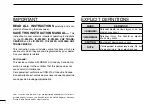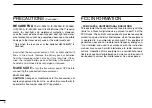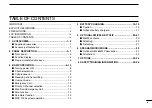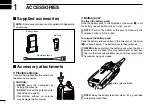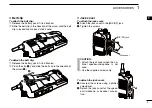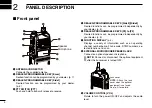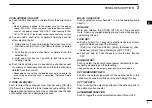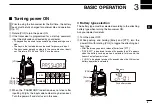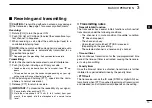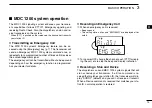
10
3
BASIC OPERATION
3
Receiving and transmitting
■
CAUTION:
Transmitting without an antenna may damage
the transceiver. See page 1 for accessory attachments.
Receiving:
Rotate [VOL] to turn the power ON.
q
Push [CH Up] or [CH Down] to select the conventional sys-
w
tem channel, in sequence.
e
When receiving a call, adjust the audio output level to a
comfortable listening level.
NOTE:
When a matched RX code signal is received, audio
from the microphone is automatically transmitted for a
specified time period.*
*
Depending on the presetting. Ask your dealer for details.
Transmitting:
Wait for the channel to become clear to avoid interference.
Push [Call] when initiating a call from your side.
q
• Coded audio may be heard from the transceiver, then “ ” ap-
pears.
• This operation may not be necessary depending on your sig-
naling system. Ask your dealer for details.
While pushing and holding [PTT], speak into the micro-
w
phone at a normal voice level.
Release [PTT] to return to receive.
e
IMPORTANT:
To maximize the readability of your signal;
1. Pause briefly after pushing [PTT].
2. Hold the microphone 5 to 10 cm (2 to 4 inches) from your
mouth, then speak into the microphone at a normal voice
level.
Transmitting notes
D
• Transmit inhibit function
The transceiver has several inhibit functions which restrict
transmission under the following conditions:
- The channel is in mute condition (‘Inaudible’ condition;
“ ” does not appear.)
- The channel is busy.
- Un-matched (or matched) CTCSS is received.
(Depending on the presetting.)
- The selected channel is a ‘receive only’ channel.
• Time-out timer
After continuous transmission for the pre-programmed time
period, the time-out timer is activated, causing the transceiv-
er to stop transmitting.
• Penalty timer
Once the time-out timer is activated, transmission is further
inhibited for a period determined by the penalty timer.
• PTTID call
The transceiver sends the ID code (DTMF or digital ANI) au-
tomatically when [PTT] is pushed (beginning of transmission)
and released (end of transmission) depends on the setting.


